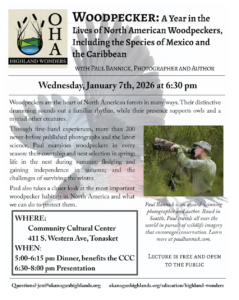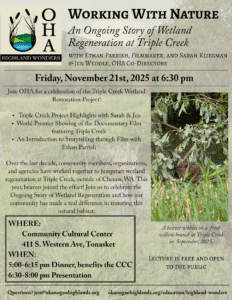New Documentary Released! Working With Nature: An Ongoing Story of Wetland Regeneration
We are so excited to announce the release of OHA’s new documentary, Working With Nature: An Ongoing Story of Wetland Regeneration
This short film paints a picture of process-based restoration as an act of reciprocity. Through hands-on efforts like planting native vegetation and constructing beaver dam analogs, Okanogan Highlands Alliance seeks to heal a degraded stream and wetland system – not by imposing control, but by listening, learning, and partnering with the ecosystem.
Found near Chesaw, Washington in the Okanogan Highlands, Triple Creek is part of a creek-floodplain system that historically supported a complex, diverse wetland. A rain-on-snow event in the late 1990’s caused the creek to incise and straighten. The wetland drained, losing its ability to slow and store water and to support wetland species.
As water slows down, spreads out, and wets the ground, native vegetation grows and flourishes, enabling diverse species, including beaver, to return to the wetland. The film explores how restoration is more than science – it’s a relationship. Woven through the physical labor are reflections on gratitude, responsibility, excitement, and what it means to repair harm done to living systems. By working with nature, we begin to regenerate the natural world that sustains us all.
Click here to learn more about Triple Creek and watch the film!
Get Lost Trail Race 2025! Registration is Open!
The date is set, the campground reserved, and registration is open! We can’t wait to see you at the 7th Annual Get Lost Trail Race!
You can find all the details about the weekend, including the schedule of events and a map of the race routes, and complete online registration at: https://ultrasignup.com/register.aspx?did=124378 or scan the QR code in the poster below. When you sign up online you guarantee that you will receive a post-race lunch, and you SERIOUSLY don’t want to miss out on the lunch.
Interested in volunteering? Send a quick message to getlost@okanoganhighlands.org. We’d love to have your help!









